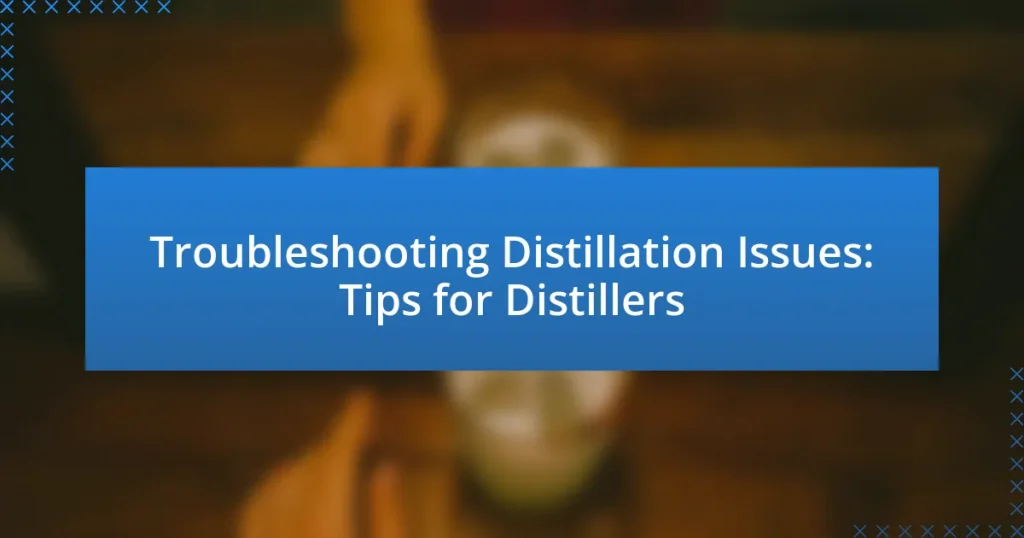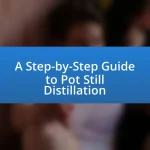The article focuses on troubleshooting distillation issues faced by distillers, highlighting common problems such as poor separation of components, off-flavors, and equipment malfunctions. It examines the impact of temperature fluctuations on distillation efficiency and outlines causes of temperature instability, along with methods to improve temperature control. Additionally, the article discusses signs of poor separation, the importance of column design, and techniques to enhance separation efficiency. It also addresses foaming issues, troubleshooting techniques, and best practices for maintaining distillation equipment, providing practical tips for optimizing distillation processes and avoiding common pitfalls.

What are common distillation issues faced by distillers?
Common distillation issues faced by distillers include poor separation of components, off-flavors, and equipment malfunctions. Poor separation occurs when the distillation column is not operating at optimal conditions, leading to insufficient separation of volatile compounds. Off-flavors can arise from the presence of unwanted compounds, often due to inadequate fermentation or improper temperature control during distillation. Equipment malfunctions, such as leaks or blockages, can disrupt the distillation process, resulting in reduced efficiency and product quality. These issues are frequently documented in distillation literature, highlighting their prevalence in both commercial and craft distilling operations.
How can temperature fluctuations affect distillation?
Temperature fluctuations can significantly impact distillation by altering the boiling points of the components being separated. When the temperature is inconsistent, it can lead to incomplete separation, resulting in a mixture of undesired compounds in the distillate. For instance, if the temperature rises too quickly, lighter components may evaporate too early, while heavier components may not vaporize adequately, causing poor separation efficiency. Studies have shown that maintaining a stable temperature is crucial for achieving the desired purity and yield in distillation processes, as fluctuations can disrupt the equilibrium necessary for effective separation.
What are the causes of temperature instability during distillation?
Temperature instability during distillation is primarily caused by fluctuations in heat input, variations in feed composition, and inadequate column design. Fluctuations in heat input can result from inconsistent heating sources or changes in the boiling point of the mixture being distilled. Variations in feed composition can lead to changes in vapor-liquid equilibrium, affecting temperature stability. Inadequate column design, such as insufficient packing or poor reflux ratios, can also contribute to temperature fluctuations by disrupting the separation efficiency. These factors collectively impact the ability to maintain a consistent temperature profile during the distillation process.
How can temperature control be improved in the distillation process?
Temperature control in the distillation process can be improved by utilizing advanced temperature monitoring systems and automated control mechanisms. Implementing real-time temperature sensors allows for precise tracking of the distillation temperature, enabling immediate adjustments to the heating source. Additionally, integrating automated control systems, such as PID (Proportional-Integral-Derivative) controllers, can optimize the heating process by continuously adjusting the heat input based on the temperature readings. Studies have shown that these technologies can enhance the efficiency and consistency of the distillation process, leading to higher purity and yield of the desired product.
What are the signs of poor separation in distillation?
Signs of poor separation in distillation include overlapping boiling points of components, unclear separation of distillate fractions, and the presence of unwanted impurities in the collected distillate. When the boiling points of the components are too close, it becomes difficult to achieve effective separation, leading to a mixture of products. Additionally, if the distillate shows a gradient of composition rather than distinct layers, it indicates inadequate separation. The presence of impurities, such as color or odor that deviates from the expected product, further confirms poor separation. These indicators are critical for distillers to identify and rectify issues in the distillation process.
How does the choice of distillation column impact separation quality?
The choice of distillation column significantly impacts separation quality by determining the efficiency of vapor-liquid contact and the number of theoretical plates available for separation. A column designed with appropriate height, diameter, and packing or tray type enhances mass transfer, allowing for better separation of components based on their volatility. For instance, a packed column typically provides a larger surface area for contact compared to a tray column, which can lead to improved separation efficiency, especially in cases where close-boiling components are present. Studies have shown that optimizing column design can increase purity levels by up to 20% in certain applications, demonstrating the critical role of column selection in achieving desired separation outcomes.
What techniques can enhance separation efficiency?
Techniques that can enhance separation efficiency in distillation include optimizing column design, adjusting reflux ratios, and utilizing advanced separation technologies such as membrane separation and extractive distillation. Optimizing column design involves selecting appropriate packing materials and column height to improve mass transfer and reduce pressure drop. Adjusting reflux ratios allows for better separation of components by increasing the liquid returned to the column, which enhances the purity of the distillate. Advanced separation technologies, like membrane separation, can selectively separate components based on size or affinity, while extractive distillation introduces a solvent to alter relative volatilities, further improving separation efficiency. These techniques are supported by empirical studies demonstrating significant improvements in separation performance under various operational conditions.
Why is foaming a problem in distillation?
Foaming is a problem in distillation because it can lead to operational inefficiencies and product contamination. When foam forms in the distillation column, it can cause liquid to carry over into the vapor phase, resulting in a loss of separation efficiency and potential contamination of the distillate with undesired components. This phenomenon can also increase pressure drop across the column, leading to reduced throughput and potential flooding, which disrupts the distillation process. Studies have shown that foaming can be exacerbated by factors such as high feed concentrations and the presence of surfactants, making it crucial for distillers to manage these conditions to maintain optimal performance.
What factors contribute to foaming in distillation systems?
Foaming in distillation systems is primarily caused by the presence of surface-active agents, high vapor velocities, and impurities in the feed. Surface-active agents, such as surfactants or certain organic compounds, reduce the surface tension of the liquid, promoting bubble formation. High vapor velocities can lead to increased turbulence, which enhances bubble generation and retention in the liquid phase. Additionally, impurities, including oils or particulates, can stabilize foam by creating a film around bubbles, preventing their collapse. These factors collectively contribute to operational challenges in distillation processes, impacting efficiency and product quality.
How can foaming be minimized during the distillation process?
Foaming during the distillation process can be minimized by controlling the boiling rate and using anti-foaming agents. A slower boiling rate reduces turbulence, which in turn decreases the likelihood of foam formation. Additionally, incorporating anti-foaming agents, such as silicone-based compounds, can effectively reduce surface tension and prevent foam from developing. Studies have shown that the use of these agents can significantly lower foam levels, enhancing the efficiency of the distillation process.

What troubleshooting techniques can distillers use?
Distillers can use several troubleshooting techniques to address common issues in the distillation process. These techniques include monitoring temperature and pressure, checking for leaks, inspecting equipment for cleanliness, and analyzing the quality of raw materials. For instance, maintaining optimal temperature is crucial, as deviations can lead to unwanted flavors or poor separation of components. Additionally, ensuring that all seals and connections are airtight prevents vapor loss, which can affect yield and quality. Regular cleaning of stills and other equipment is essential to avoid contamination and buildup that can impair performance. Lastly, evaluating the quality of the ingredients used can prevent issues related to fermentation and distillation, as poor-quality raw materials can lead to off-flavors and inefficiencies.
How can distillers diagnose issues effectively?
Distillers can diagnose issues effectively by systematically analyzing the distillation process and identifying deviations from expected outcomes. This involves monitoring key parameters such as temperature, pressure, and flow rates, as well as conducting sensory evaluations of the distillate for off-flavors or aromas. For instance, a sudden increase in temperature may indicate a blockage or malfunction in the system, while unusual flavors could suggest contamination or improper fermentation. By employing these diagnostic techniques, distillers can pinpoint the root causes of issues and implement corrective measures to ensure product quality and operational efficiency.
What tools are essential for troubleshooting distillation problems?
Essential tools for troubleshooting distillation problems include a thermometer, pressure gauge, and refractometer. The thermometer allows for precise temperature monitoring, which is critical for identifying boiling point discrepancies. The pressure gauge helps in assessing the system’s pressure, ensuring it operates within the desired range. A refractometer measures the concentration of components in the distillate, aiding in determining separation efficiency. These tools collectively provide vital data that can pinpoint issues in the distillation process, enabling effective troubleshooting.
How can data logging assist in identifying distillation issues?
Data logging assists in identifying distillation issues by continuously recording operational parameters such as temperature, pressure, and flow rates throughout the distillation process. This real-time data collection enables distillers to analyze trends and detect anomalies that may indicate inefficiencies or malfunctions. For instance, a sudden spike in temperature could signal a blockage or malfunction in the distillation column, while inconsistent pressure readings may reveal leaks or equipment failures. By reviewing historical data logs, distillers can correlate specific operational conditions with performance outcomes, allowing for targeted troubleshooting and optimization of the distillation process.
What are the best practices for maintaining distillation equipment?
The best practices for maintaining distillation equipment include regular inspection, cleaning, and calibration. Regular inspection helps identify wear and tear, while cleaning prevents contamination and buildup that can affect efficiency. Calibration ensures that the equipment operates within specified parameters, which is crucial for optimal performance. Additionally, using high-quality materials and following manufacturer guidelines can enhance the longevity and reliability of the equipment. These practices are supported by industry standards, which emphasize the importance of maintenance in achieving consistent distillation results.
How often should distillation equipment be inspected and cleaned?
Distillation equipment should be inspected and cleaned regularly, ideally after every use or at least once a week for frequent operations. Regular inspections help identify wear and tear, while cleaning prevents contamination and buildup of residues that can affect product quality. Industry best practices recommend that equipment be thoroughly cleaned and inspected to maintain efficiency and safety standards, as outlined by organizations such as the American Society of Mechanical Engineers (ASME).
What maintenance routines can prevent common distillation problems?
Regular maintenance routines that can prevent common distillation problems include routine cleaning of equipment, regular inspection of seals and gaskets, and calibration of temperature and pressure sensors. Cleaning equipment, such as condensers and boilers, removes residues that can lead to fouling and reduced efficiency. Inspecting seals and gaskets ensures that there are no leaks, which can cause pressure drops and contamination. Calibrating sensors maintains accurate readings, preventing operational issues that arise from incorrect temperature or pressure measurements. These practices are essential for maintaining optimal performance and preventing costly downtimes in distillation processes.

What are some advanced tips for troubleshooting distillation issues?
To troubleshoot distillation issues effectively, distillers should first analyze the temperature profiles at various stages of the distillation process. Monitoring the temperature can reveal whether the system is operating within the desired range, indicating potential issues with heat input or reflux ratios. Additionally, inspecting the column packing and ensuring it is clean and properly installed can prevent issues related to mass transfer efficiency.
Another advanced tip involves evaluating the feed composition and flow rate; variations can lead to fluctuations in product quality. Implementing a control system that adjusts parameters in real-time based on feedback can enhance stability. Furthermore, conducting a thorough examination of the condenser and ensuring it is functioning optimally can prevent vapor losses and improve overall efficiency.
These strategies are supported by industry practices that emphasize the importance of precise control and monitoring in distillation processes, as highlighted in various distillation engineering texts.
How can distillers optimize their processes for better results?
Distillers can optimize their processes for better results by implementing precise temperature control and enhancing fermentation techniques. Precise temperature control ensures that the distillation process occurs at optimal points, which can significantly improve the quality and yield of the final product. For instance, maintaining a consistent temperature during distillation can prevent unwanted compounds from being carried over, leading to a purer spirit. Additionally, enhancing fermentation techniques, such as using high-quality yeast strains and monitoring pH levels, can increase alcohol yield and improve flavor profiles. Research indicates that optimizing these parameters can lead to a 10-20% increase in overall efficiency and product quality in distillation processes.
What role does the choice of raw materials play in distillation success?
The choice of raw materials is critical to distillation success as it directly influences the quality, flavor, and yield of the final product. High-quality raw materials, such as specific grains, fruits, or botanicals, contain essential compounds that contribute to desirable characteristics in the distilled spirit. For instance, the sugar content in fruits affects fermentation efficiency, while the type of grain can impact the flavor profile of whiskey. Studies have shown that using premium ingredients can enhance the aromatic and taste qualities of spirits, leading to higher consumer satisfaction and market value. Therefore, selecting appropriate raw materials is fundamental for achieving optimal distillation outcomes.
How can distillers adjust their techniques based on environmental conditions?
Distillers can adjust their techniques based on environmental conditions by modifying temperature control, fermentation times, and ingredient selection. For instance, higher ambient temperatures may require distillers to lower the fermentation temperature to prevent off-flavors, while cooler conditions might necessitate longer fermentation periods to achieve desired alcohol levels. Additionally, humidity can affect the evaporation rates during distillation; in high humidity, distillers may need to increase heat to maintain the desired proof. These adjustments are essential for maintaining product quality and consistency, as evidenced by studies showing that temperature fluctuations can significantly impact the flavor profile of distilled spirits.
What are the most common mistakes distillers make during troubleshooting?
The most common mistakes distillers make during troubleshooting include overlooking equipment calibration, failing to document processes, and not considering environmental factors. Equipment calibration is crucial; inaccuracies can lead to improper measurements and flawed outcomes. Documenting processes helps identify recurring issues, yet many distillers neglect this, making it difficult to pinpoint problems. Additionally, environmental factors such as temperature and humidity can significantly affect distillation, but they are often underestimated. These mistakes can lead to inefficient operations and compromised product quality.
How can distillers avoid these common pitfalls?
Distillers can avoid common pitfalls by implementing rigorous quality control measures throughout the distillation process. This includes regularly calibrating equipment to ensure accurate measurements, conducting thorough inspections of raw materials to prevent contamination, and maintaining precise temperature and pressure settings during distillation. Research indicates that distilleries with established quality control protocols experience fewer production errors and higher product consistency, as evidenced by a study published in the Journal of Food Science, which highlights the correlation between quality control practices and product quality in alcoholic beverages.
What resources are available for continuous learning in distillation troubleshooting?
Resources available for continuous learning in distillation troubleshooting include online courses, industry webinars, and technical publications. Online platforms such as Coursera and edX offer courses specifically focused on chemical engineering and distillation processes, enhancing practical knowledge. Industry webinars hosted by organizations like the American Institute of Chemical Engineers (AIChE) provide insights from experts on troubleshooting techniques. Additionally, technical publications such as the “Journal of Chemical Engineering” and “Chemical Engineering Progress” feature peer-reviewed articles that discuss recent advancements and case studies in distillation troubleshooting, ensuring that learners stay updated with the latest methodologies and technologies in the field.
What practical tips can help distillers resolve issues quickly?
Distillers can resolve issues quickly by implementing systematic troubleshooting techniques. First, they should maintain detailed records of each distillation process, including temperatures, times, and ingredient variations, which helps identify patterns and anomalies. Second, conducting regular equipment maintenance ensures that all components function optimally, reducing the likelihood of mechanical failures. Third, distillers should utilize sensory evaluation, such as taste and smell, to detect off-flavors or aromas early in the process, allowing for timely adjustments. Additionally, engaging in peer consultations or industry forums can provide fresh perspectives and solutions to common problems. These practices are supported by industry standards that emphasize the importance of documentation, maintenance, and community engagement in effective distillation management.


